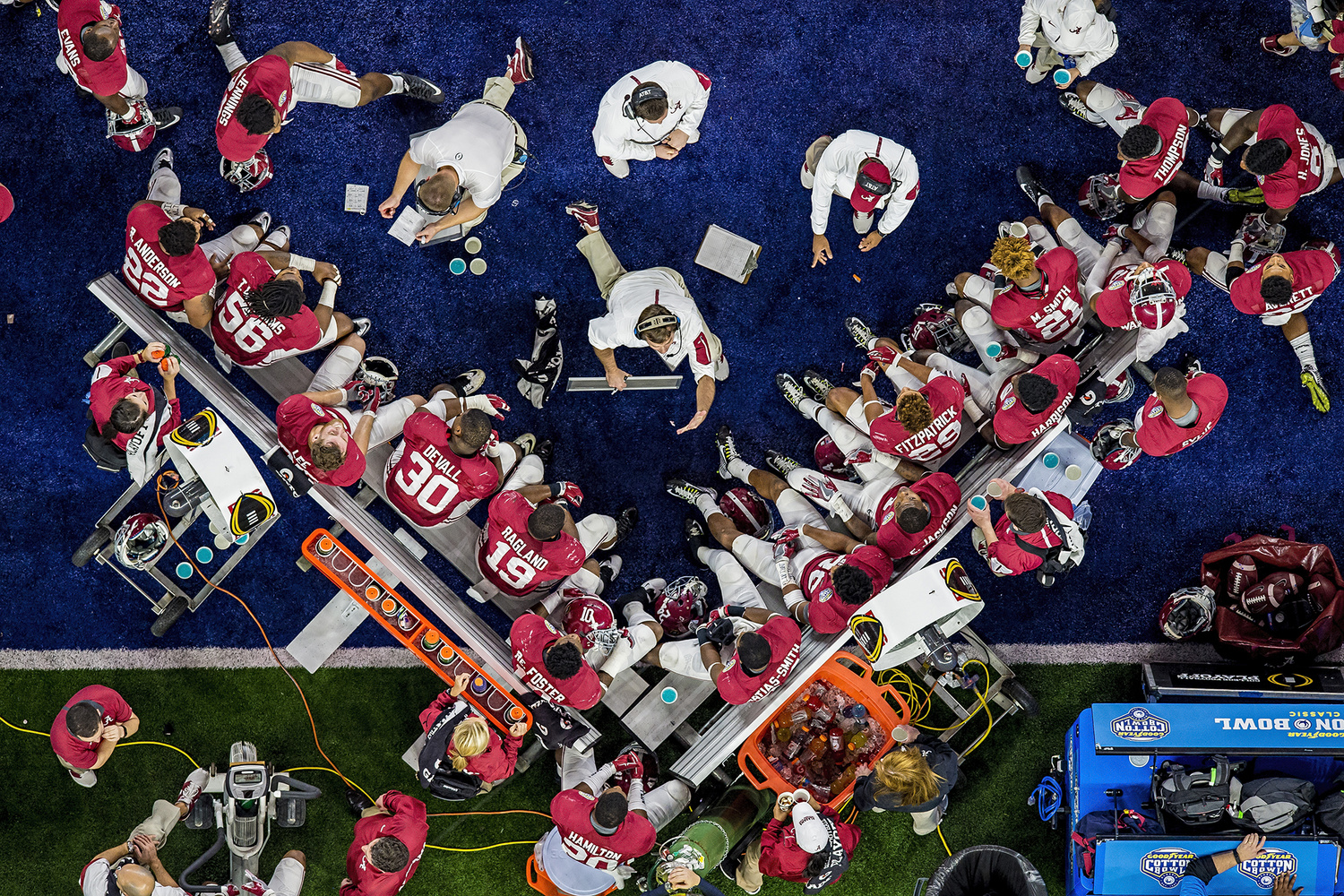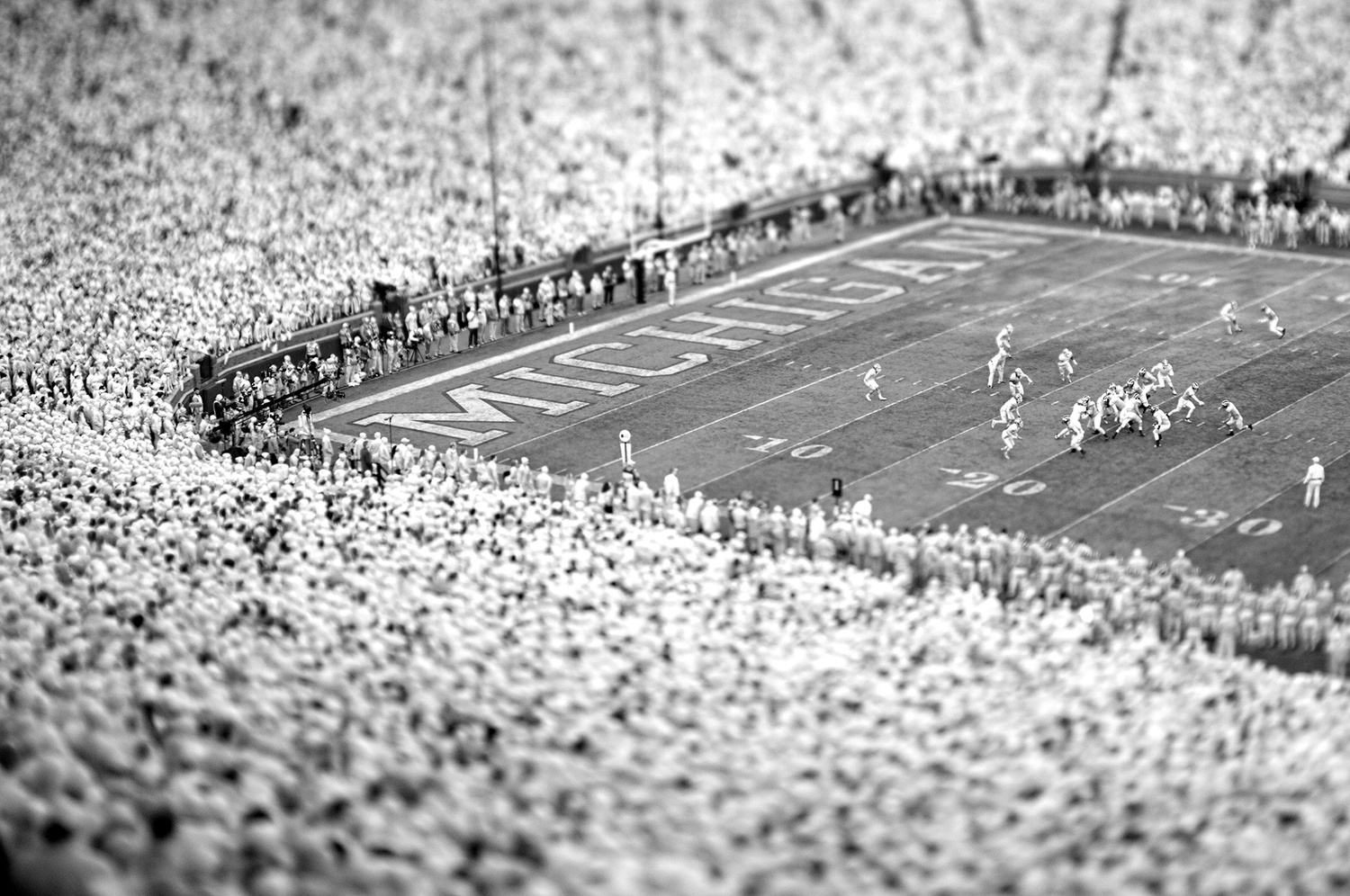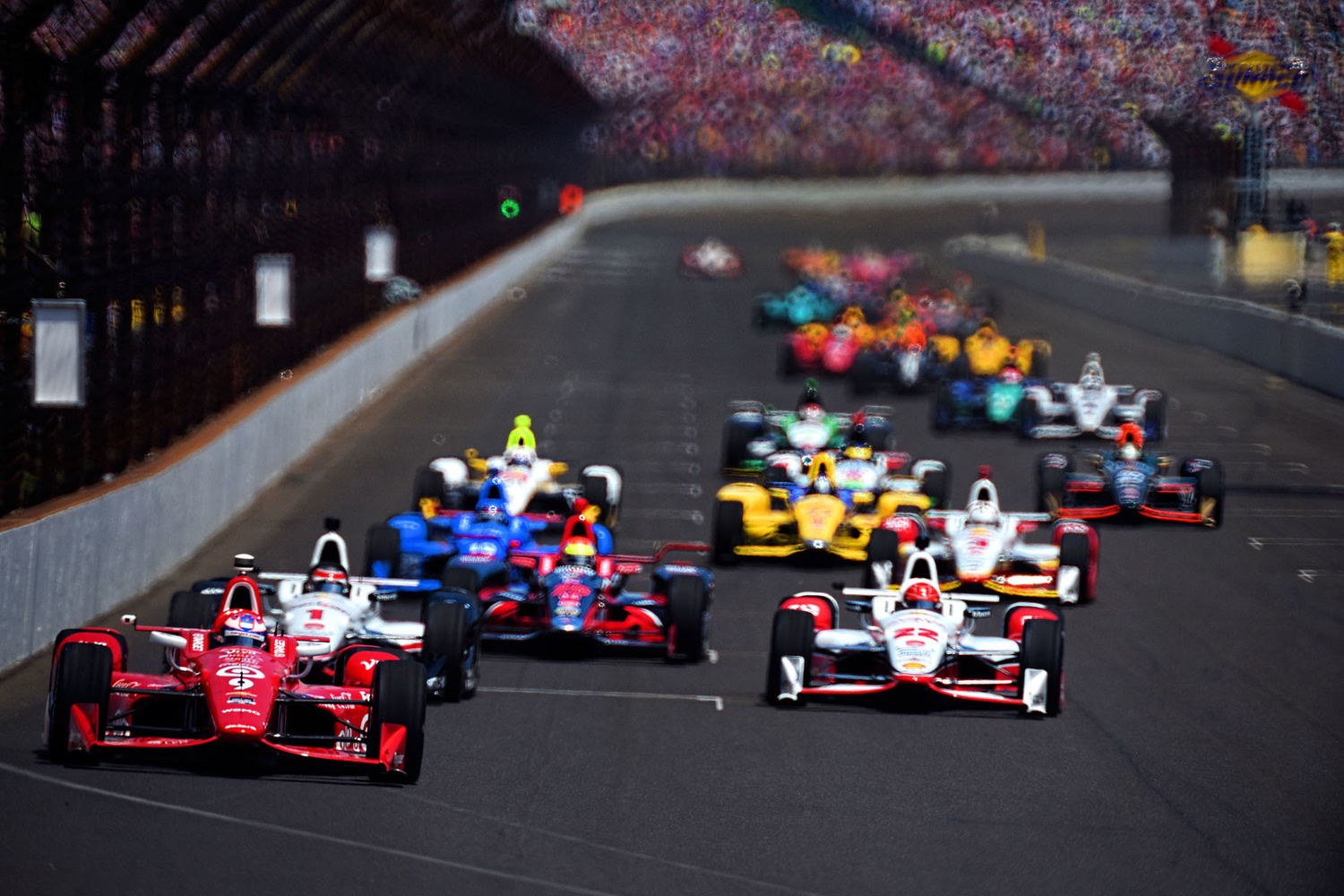Your headache from over-drinking (either in celebration or in deep depression) may be wearing off, but for those that had to photograph Super Bowl 50, that headache began days before the big day. The preparation for covering the game took its toll on those that enable us look back on it this week. Fstoppers caught up with ESPN photographer Andrew Hancock to get a look into the gear, setup, and planning to cover the most important event of America’s favorite sport.
Although the breadth of his work covers a far wider gamut of genres, Hancock has covered his fair share of sporting events in his career as a photographer. Shooting American Pharaoh’s Triple Crown win at the Kentucky Derby, capturing the world’s fastest cars at the Indy 500, covering the 38–0 Cotton Bowl on New Year’s Eve; these are any sports shooter’s dream assignments, not the least of which also include Sunday’s assignment for ESPN’s coverage of Super Bowl 50.
Overhead shot of Alabama's Crimson Tide on the bench during the 2015 Cotton Bowl, where Alabama shut out the Michigan State Spartans 38–0 at the Dallas Cowboys' AT&T Stadium. Photo: Andrew Hancock for ESPN, previously unpublished.
There’s no doubt that covering these events means being able to work under pressure. Deadlines are as tight as they come. After all, few things have to be turned in just 40 minutes after the last shot was taken, as was the case after the Kentucky Derby’s trophy shots. If that deadline isn’t tight enough for you, photographers including Hancock were all tethered to Ethernet cables in order to transfer photos immediately for Instagram and other social media outlets, along with sports journalism galleries online as the Cotton Bowl game unfolded just hours before entering 2016. Even card runners weren’t fast enough for the demands of that game.
Needless to say, modern photojournalism doesn’t just require great gear (although that helps plenty). More than this, it demands precisely laid out advanced planning days before the actual game in order to take advantage not only of the gear at hand, but also of the limited time over which the game actually takes place.
Michigan State Spartan Kodi Kieler (79) grabs a defender as his helmet comes off and as Spartan quarterback Connor Cook (18) is brought down by the Tide's Jonathan Allen (93) during the 2015 Cotton Bowl at AT&T Stadium in Dallas. Photo: Andrew Hancock for ESPN, previously unpublished.
Speaking on the phone with us Friday at 4 p.m., less than 48 hours from the Super Bowl 50 kickoff, Hancock had already set up his 4 camera rigs. Each has their own coverings against the elements, but he made note that he might switch the position of one that he wasn’t as happy with Saturday, when he’ll also put the PocketWizards up. Thursday he had already scouted the light in the stadium at the time of the game, thankful that he’s in sunny California, but disappointed that the height of the press box would certainly block light by kickoff time. A week before all of this, Hancock was scouting online and doing research about what the NFL most likely would and would not allow, although that changes year to year.
Andrew Hancock's D4s is set up in the catwalk for a shot on top of one of the Super Bowl 50 logos on the field.
Super Bowl 50 is underway as one of Andrew Hancock's remote cameras catches the sun peaking through onto the field for a moment.
Peyton Manning celebrates his win with the Super Bowl 50 trophy after the game. All shots: Andrew Hancock for ESPN
While Hancock was happy to let Nikon’s on-site team provide a loaner 600mm f/4 lens and three D4s bodies, his go-kit isn’t exactly light, either. After all, he had a rather ridiculous five bodies on him during the game in the following configurations: D4s with the 600mm f/4, D4s with the 400mm f/2.8, D4s with the 70-200mm f/2.8, D750 with the 24-70mm f/2.8, and one more D4s with a 14-24mm f/2.8. Meanwhile, two D810s and two D4 bodies that he traveled with filled the needs of his remote rigs. One does what it takes, I suppose.
Laid out on the table before his trip to Super Bowl 50 are 6 Nikon DSLR bodies, 10 lenses, extra batteries, at least 10 memory cards (Lexar CF and Sony XQD), G-Technology ev RaW SSD and ATC drives, a 15-inch Retina MacBook Pro, a Lexar tower card reader, an iPad, an iPhone, Bose QC20i noise-cancelling earbuds, an X-Rite ColorChecker Passport, a monopod, and a Giottos Rocket Blaster.
You may notice the omission of a D5 body. Hancock regretted having to “burst [my] bubble” with that news, but I have a strong feeling he was at least slightly more disappointed with the news himself. Still, he looked forward to using the D5 soon, but obviously not quite soon enough.
Andrew Hancock's two Pelican cases, a ThinkTank roller, and a ThinkTank shoulder bag are packed at home, ready for Super Bowl 50.
For all of the world’s biggest sporting events, getting photos up after the game isn’t enough. The best outlets post images, videos, and stories just minutes after a play unfolds on the field. ESPN has a detailed plan for when and where each card runner will meet a photographer throughout every minute of the game. As they’re running the plan, however, runners still go to each photographer after every key play to give them fresh cards, but more importantly to get that play’s photos up to one of three editors who ingest them through a Lexar HR-series card reader tower, G-Technology ev SSD drives, and to Retina MacBook Pros from where the final photos get uploaded to ESPN.com faster than you would expect after the excitement of an interception or touchdown. There’s no time to reflect or to enjoy, you miss something if you hesitate just one second. As with all news, the key is to be immediate and current. The ultimate goal one day is to push content as fast as points get added to the scoreboard.
Andrew Hancock captured this day of Michigan football with a tilt-shift lens. Photo: Andrew Hancock for The Players' Tribune.
Having multiple photographers at the event also helps. Not only are more plays covered from more angles, but the movement that photographers at big games like the Super Bowl are limited to also means that, at one point or another, only one photographer will be in the view of the play anyway. During that one or two-second leap for an interception in the final two minutes of the fourth quarter, one of your three photographers better be there. That’s where the coordination of ESPN’s team, also including Bill Frakes and Laura Heald (both of StrawHatVisuals), really counts. For Super Bowl 50, ESPN had Hancock and Frakes both out on the field while Heald shot from a fixed position in the stands and the event's Director of Photography, Tim Rasmussen, also filled in behind the camera. Meanwhile, a fifth team member, Preston Gannaway, was also on assignment, roaming the stadium for the right shot.
Undoubtedly, these high-stake events take more stamina than any other field. But Hancock is used to proving himself since taking his first job at a local Indiana newspaper straight out of journalism school. “I was willing to go anywhere,” Hancock said, discussing his post-college start in photo-journalism. “I had never been north of the Mason-Dixon or east of the Mississippi,” the Texas-native continued, “so I went, kind of threw myself into the deep end… I didn’t do a lot of the internships that a lot of the photographers do now — the two internships I did for were for writing — so I had to start at the bottom of the ladder and really had to prove myself.”
Last year, American Pharaoh won the Kentucky Derby, the first win of the three races that would earn him the first Triple Crown since 1978. Photo: Andrew Hancock for The New York Times.
When asked about his transition from journalism, a discipline almost solely rooted in the ability and skill of written storytelling, to photojournalism, Hancock mentioned growing up in a home where there was always a camera around, which inevitably sparked his interest in photography as a medium through which to tell stories. “I just love telling stories. I always felt that photography was the most efficient way for me to do that.”
Portrait of a Texas A&M in mid stroke of a butterfly lap. Photo: Andrew Hancock.
After the Indiana paper, Hancock eventually found himself shooting for a variety of clients including Sports Illustrated, a publication he has contributed to for the last nine years. And even with his Nikon Ambassadorship helping to secure him loaner gear for the game, he still carries around an immense kit. Hancock certainly won’t be the kind of person you see transitioning to an APS-C mirrorless setup anytime soon; the sports/journalism photographers never are. For Hancock, the key is in having reliable equipment with multiple copies of everything between his editors and his own MacBook and G-Technology drives.
At the end of the day, Hancock’s success is determined more by his preparation than by anything else. But getting a shot that will be remembered for a lifetime still comes down to a little bit of luck. Finishing up, Hancock hopefully noted, “I hope the plays run the right way — toward me — and that I’m not stuck behind a ref standing in front of me.”
The vibrant colors of the crowd in the background echo those of each car racing during 2015's Indy 500. Photo: Andrew Hancock for Autoweek.
Want to see more images of Super Bowl 50? Check out ESPN's fantastic behind-the-scenes footage of everything from the players to Lady Gaga to Cam Newton showing up to the game with headphones and in a camouflage sportcoat.
Featured image: The Panthers' Jonathan Stewart (28) leaps over his own blockers and the Broncos' defense for a one-yard touchdown. Photo: Andrew Hancock for ESPN.
All images used with permission. For more images, check out ESPN's Super Bowl 50 gallery.



















Or be Kevin Durant...
What's up with the bokeh in the Indy 500 shot? Mirror lens?
I was thinking the same thing. Could it be from the fumes or heat coming off of the cars?
I've shot Indy for the last 25 years and was shooting the start of the 2015 race opposite from Andrew at the catch fence in Turn 3 looking down the back stretch. The bokeh seen here is not normal. While you will get plenty of heat distortion from about the 3rd or 4th car on back, with a refracting lens you don't get the circles.
That shot was taken with a Nikkor 500mm f5 mirror lens made back in 1960.
Andrew, nice application of a vintage lens. Here was the view from the opposite end of the track:
70% of the superbowl photographers shot with Canon and the rest Nikon. That seems strange, where were the Sony shooters? Don't they have the fastest AF and the most popular cameras now that everyone is leaving Canon?
Sony tends to be mirrorless, right? Also, low FPS, right? ;-)
I'm extremely excited to see what the future of mirrorless technology holds for us. And Sony is an awesome part of that evolution (they've done great things lately). However, even today, I think it would be a rush to look at AF numbers and discount the value of good tracking technology like that in the D5, for example. Of course, that didn't make it to the Super Bowl this year (or at least not into Andrew's hands), but if you've seen some of the videos through the viewfinder while that camera is tracking...it's incredible, and you'll immediately understand the difference...
And after all of that, some dolt will drop comment on how disappointed they are with the video features on the new D5 are.
THIS -- is why we don't care whatsoever. These are made for speed, workflow and being rugged. Full Stop.